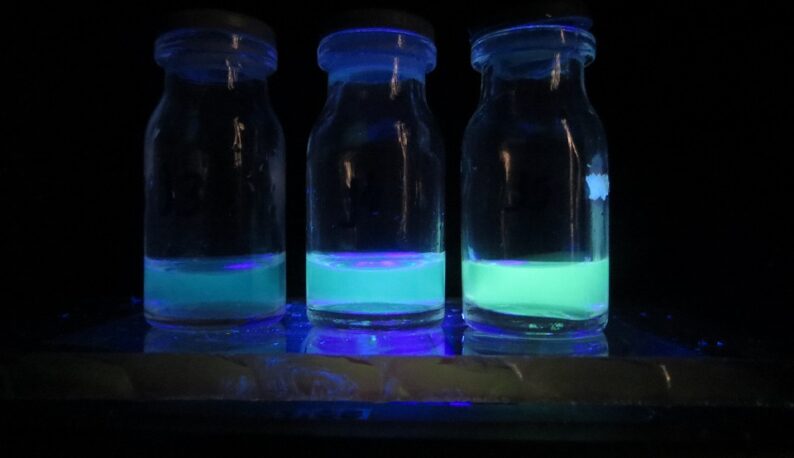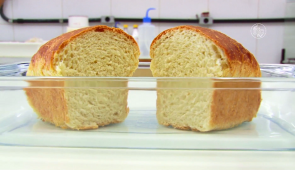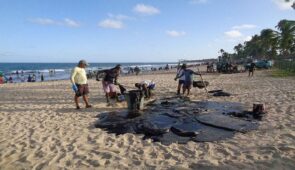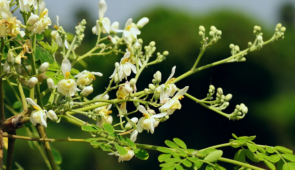The growing number of pesticides licensed for use in Brazilian produce and their often indiscriminate application have drawn the attention of researchers at UFC’s Graduate Program in Chemistry (PGQUIM). Partnered with two Chilean universities, they decided to create a faster, less expensive way of detecting pesticides in food by resorting to light signals.
The basic idea seems quite simple: mixing the food in a chemical solution with a fluorescent probe. If the solution glows at a specific intensity, it means that the food is contaminated with pesticides. Additionally, it is possible to find out which substance is present in the sample by observing the light that was emitted: each intensity refers to a different compound.
The research is led by the Advanced Materials Chemistry Group (GQMAT-UFC), who has published an article about the invention in Sensors and Actuators B: Chemical, an international scientific journal. Their work won the Ícaro de Sousa Moreira Award granted by the University’s Graduate Program in Chemistry (PGQUIM).
Since 2016, the group has been studying the application of carbon quantum dots (CQDs) in protein identification. These are nanoparticles (when the order of magnitude of the particles is nine times smaller compared to the meter’s) which have excellent characteristics of biocompatibility and light emission control. As of 2018, the researchers decided to adapt this methodology for the purpose of identifying pesticides, so as to provide a more tangible contribution to the community.
To that end, they devised the following technique: promoting an interaction between the CQDs and another nanomaterial, which would be a metallic nanoparticle. The combination of these two nanomaterials resulted in the fluorescent nanoparticles, which in turn make possible the sensing strategy for distinguishing the different toxic substances contained in the food samples.
The study conducted tests with rice, oranges, bell peppers, and carrots. “The food products were selected based on reports by the Brazilian Health Regulatory Agency (ANVISA), which inform the crops where pesticides under analysis are more likely to be found, since their application in agriculture is allowed under a certain concentration”, Samuel Veloso Carneiro, a Ph.D. student of the PGQUIM and one of the researchers involved with the study, told Agência UFC.
According to Professor Rafael Melo Freire, a partner in the study through the Universidad Autónoma de Chile and researcher at the Centro para el Desarrollo de la Nanociencia y Nanotecnología (CEDENNA), the sensing technology works for any type of food, as long as there is a previously assembled database containing the relevant information.
“Our strategy consists of creating a set of light signals that would enable the identification of each pesticide present in the food sample. We can understand this set of signs as a unique identification number for each of the pesticides investigated in the study, similar to the human fingerprint. In practice, so far, our database allows us to identify the toxic substances in rice, oranges, bell peppers, and carrots. However, we do encourage other researchers to continue the work, using the same methodology and experimental conditions, in order to keep enlarging the available databases for the detection of many other pesticides”, Freire illustrates.
The method developed by GQMAT-UFC is much simpler and cheaper than other techniques available in he market, such as chromatography, for example. Professor Pierre Fechine, who coordinates GQMAT and this research, envisions two potential target audiences for this invention, in its current phase. One of them would be the big buyers, those who purchase foodstuffs on a large scale from small-scale producers or agro-entrepreneurs to resell it to food supply centers, such as the Brazilian CEASAs. The reason for this is that the technique still requires the use of laboratory
equipment. Another target audience would be the regulatory agencies, which could use it to monitor the amount of pesticides in the foods available in the market.
What sets the UFC strategy apart is that, unlike the previously used methods, the proposed model does not require a specialist to interpret the results. “Big buyers will be able to carry out the analysis by dropping a sample of the extract from one of the aforementioned foods in the chemical suspension containing the fluorescent probe”, the Ph.D. student clarifies.
SENSING TECH
The research is currently in progress and now the goal is to develop a product that eliminates the need for laboratory equipment. “We continue to work towards creating a user-friendly device that small-scale farmers and even final consumers could operate and therefore be able to detect pesticides in food”, Fechine tells Agência UFC. This second step would be achieved with the manufacture of some kind of sensor that can detect toxic substances in food samples, in a way that is innovative, fast, and with a low-cost.
The sensor is under development in the form of detection kits which would contain all the necessary supplies for identification and an optical detection device to observe the variation in fluorescence intensity. In addition to confirming the presence of pesticides in food, researchers are already studying the possibility of detecting different concentrations of plant protection products.
Once finished, the product will be made available through the agency of an S&T start-up incubated at UFC. Professor Fechine reveals that the group is already working on business models ideas and is open to partnerships that can help with commercialization.
RESEARCHERS
At the moment, seven researchers are working on the project. In addition to the coordinator, Professor Pierre Fechine; the UFC’s Ph.D. student, Samuel Veloso; and the professor of the Universidad Autónoma de Chile, Rafael Melo Freire, also participating in the study are the UFC-based researchers Ronaldo Ferreira do Nascimento (a professor at the Analytical and Physical Chemistry Department), Antônio Alvernes Carneiro Cruz (Ph.D. student), and Lillian Maria Uchôa Dutra Fechine (a postdoctoral fellow at GQMAT). Professor Juliano Casagrande Denardin, from the Universidad de Santiago de Chile, is also actively involved with the research.
Sources: Professor Pierre Fechine, GQMAT Coordinator – fechine@ufc.br; Samuel Veloso Carneiro, GQMAT researcher – samuel07_veloso12@hotmail.com
Translation: Isabelly Maia – Research Assistant at UFC’s Translation Laboratory (LETRARE/PROINTER)






